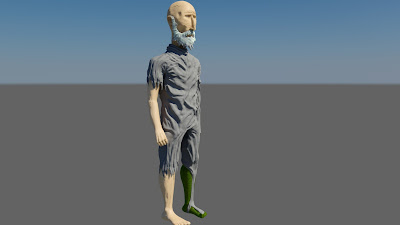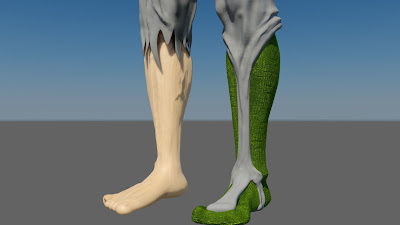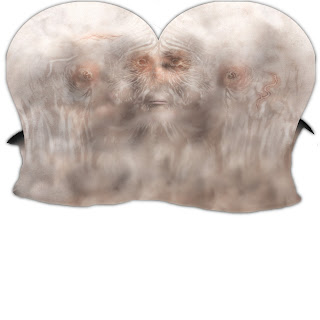Some advice: stock up on warm clothes and canned food, this post is looooooooooong...
 |
| Mudbox: Screwing up hard work on a computer near you. |
I've finally finished exporting my sculpt from Mudbox, which has been a complete pain, because while I finished the sculpt a day or so ago the displacement maps have been playing up in Maya. So for myself and anyone else trying this I'm going to make some bullet points so I don't spend ages experimenting next time I have to do this.
 |
| Displacement maps do work, but only if you ask really nicely |
- You can export using both subdivision and raycasting methods, subdivision is faster but limited to one object, raycasting uses more memory and is less stable and has more settings: so more room for error
- There are options to smooth target and source meshes and smooth UVs. These are all necessary for a correct displacement apparently, otherwise the maps exports with un-smoothed values.
- Stick with floating point EXR's, any 32bit format should work but this one ensures compatability and quality.
- Make sure you export the base level meshes from your sculpt back into Maya as they probably changed significantly from the meshes you started with.
- When you connect the displacement map to the displacement node of the shading group make sure you then go to that objects displacement attribute and click calculate bounding box so it can figure out how much displacement is going to take place.
- If you're doing this with a mental ray shader you make have some errors so do it with a lambert or something, and then when the bounding box is calculated you can apply the mental ray shader back to the object.
- Sometimes subdividing the base mesh with the displacement on top improves the appearance of the tessellation.
 |
| Yes, he even has hair. Yes its shiny as f*ck |
I have literally been sat in my room in my pyjamas for two days finishing the sculpt and trying to figure this crap out and, while not healthy, I actually feel like it might all be finished in time for the deadline, and to a much higher standard than I hoped for halfway through this project. It's probably not going to be as perfect as I initially imagined, but its encouragingly close. All that's left to do is paint textures which, apart from the face, should be fairly quick.
 |
| Noel Paisley Ladies & Gentlemen |
 |
| Gauntlet close up |
 |
| Sock (couldn't think of an epic equivalent) close up |
 |
| Ignore the tip of his beard geometry protruding from under the hair, I haven't yet figured out how to cover it in hair. |
 |
| Did I get a bit render happy? Yes but I that it is both justified and well earned. |
When sculpting was too much I sheltered within the familiar confines of Photoshop and tried to get something presentable in terms of concept art for the pitch project. Teaser:
 |
| Thomas Farriner Makes His Escape |
Amazing what blending modes and a couple of textures can hide ;)
The Animated Analysis that tanked in terms of marks (though not as much as my dissertation proposal) but which I'm quite proud of (though not so much now I'm told its not worth an academic damn).
Analysis of an Animated Work:
Immersion & Emergent Storytelling in Far Cry 2 (Ubisoft, 2008)
Most people would classify Far Cry 2 as part of the open world, first person shooter genre (FPS). This is a rare hybridisation, so uncommon in fact that the sub-genre of the 'corridor shooter' has become ubiquitous when describing most FPS games, as many of these games take place in environments where the player is funnelled down a series of corridors in a restrictively linear fashion; both in terms of narrative structure and level design. This is perhaps where Far Cry 2 innovates the most but also where it stumbles, most likely due to the massive scope of the game world that is being represented in game for the player.
Immersion can often share a close relationship with the technology of a game. When the player needs to be sold on the illusion the game is offering in order for them to suspend their disbelief, their sensory connection to the game is one of the most important elements. Hence the emphasis on graphical fidelity, sound design, and the perpetual existence of the game world that Murray hints at in her writing on immersion (Murray , 1999: 105). There are a number of ways that Far Cry 2 strives to maintain perpetual existence of its world that work to enhance player immersion.
There are no loading screens, no pauses while the player is forced to wait, in an open world game this a difficult but necessary technological achievement. Jesper Juul talks about the way a game has fictional time and a play time where time in the game world is fictional time, whilst play time is time as the player experiences it. He gives the example of the loading screens in Half Life maintaining fictional time by pausing to stream data, but disrupting play time (Juul, 2005: 143). Far Cry 2's lack of load screens (except for when the player boots the game before playing) allows the fictional time and play time to remain in sync. In this way suspension of disbelief can be sustained, and the player is immersed for longer stretches of time.
Far Cry 2 uses a safe house system where the player can 'save' their game by sleeping on a camp bed. Save games in Far Cry 2 allow the player to rest his character for a chosen amount of time using a watch on the character's wrist, this is the only example of fictional time breaking away from play time and it is portrayed by a time lapse of the world outside the safe house. As the sun lowers in the sky the weather changes, non-player characters (NPC's) whiz around, and the player is shown how the game world is in perpetual existence. It continues to exist without him or her, which creates a believability in the procedural nature of the game world and it's various systems.
The animation system in Far Cry 2 plays a big part in the player's immersion, the game shuns the use of the cut scene, a technique ripped straight from the frames of its moving image sibling, film. Instead the player is fixed to the first person perspective of their character continuously . This means that every action the player performs is done using their own digital hands, without the use of an obtrusive user interface or heads-up-display. For example Far Cry 2 allows the player to navigate its 50km open world (an unnamed African country in the middle of civil war) using a map, which the player carries in the hand and can examine at any time. When the player finds a vehicle, they enter it without leaving the first person perspective, with animations provided for every action. The same goes for firing, reloading, and unjamming weapons, repairing vehicles or swimming.
Far Cry 2 also has a unique approach to first aid. While it borrows the rather tired convention of the health pack to heal a players wounds, when the player is critically wounded, they must retreat from battle and tend to their ailment. This cues a brief animation of the player reaching down and say, pulling some shrapnel from a leg, or fixing a dislocated knee joint. This insistence on a first person perspective, perpetual world existence, and 1:1 fictional and play time all follow an uncompromising design ethos that match the brutal nature of the games themes of idealism and greed. In this way Far Cry 2 forms a communication between designer and player though its mechanics of play, a design methodology that is described in Extra Lives and advocated by independent developer Jonathan Blow (Bissell, 2010: 93)
This unrelenting immersion can occasionally hurt the player's experience, while games have evolved beyond placing 'fun' as their only purpose, this does not mean a player is going to relish the frustration of having a game's systems punish him/her time and again. Whilst getting to a mission objective on the map, the player can begin to resent the systems that embedded them so firmly in the game world when they have to run for miles in real time, only to be gunned down in the chaos of the enemy AI and fire propagation system.
While these systems can work against the player's enjoyment of the game at times, they are what create the potential for the player-centric emergent narrative that Henry Jenkins discusses in his Narrative Architecture essay (Jenkins, 2004) and truly explore the medium's narrative potential. This approach to meaningful story relies on the 'buddy system', the characters that the player meets can rescue the player when they are failing in combat, in this way the immersion of the player is saved from being broken by a fail state or load screen after death. While the missions remain fixed, the certain elements are interchangeable, and players can make choices that allow the narrative to branch. In this way Murray's “procedural authorship” (Murray, 1999) is at last put to use as elements of the story are directed by the author's hand (the buddies) and the player takes those elements and assembles them through choices and gameplay, forging a personal and unique emergent narrative. This was taken even further by one critic who documented a 'perma-death' (a self enforced rule where once the player dies, the game is over) play through of the game and annotated the screen shots he took with anecdotes of his own emergent experiences (Abraham, 2009). This is one example of the best that Far Cry 2 can be, and a logical extension of its uncompromising nature.
Bibliography
Murray, Janet (1999) Hamlet On The Holodeck The MIT Press
Juul, Jesper (2005) Half Real The MIT Press
Jenkins, Henry (2004) 'Game Design as Narrative Architecture' in: First Person: New Media Story, Performance and Game The MIT Press
Bissell, Tom (2010) Extra Lives Pantheon Books
Websites
Games
Far Cry 2 (2008) Developed by Ubisoft Montreal [Sony Playstation 3], Ubisoft
Pixel Propaganda
Not the must cutting edge article on story in games, but its still intriguing to ascertain
the state of narrative among developers. There are two other parts also so worth reading if this piques you interest.
A wonderfully written
review of LA Noire that interprets the games world and characters in a wholly original manner.
Why sometimes I should learn to shut up about my
passions and obsessions, and why not shutting is up is so important.


 Here's how it looked in Mudbox. I tweaked it several times to try and avoid the burnt bacon look I seemed to be achieving I also used the displacement maps to add some of the wrinkle detail into the textures themselves which always help avoid that flat look you can get in a render with lots of ambient light.
Here's how it looked in Mudbox. I tweaked it several times to try and avoid the burnt bacon look I seemed to be achieving I also used the displacement maps to add some of the wrinkle detail into the textures themselves which always help avoid that flat look you can get in a render with lots of ambient light.





















